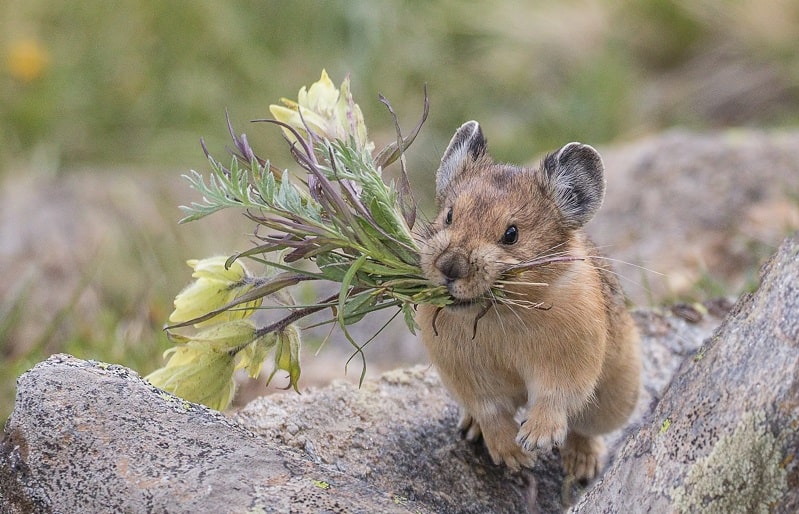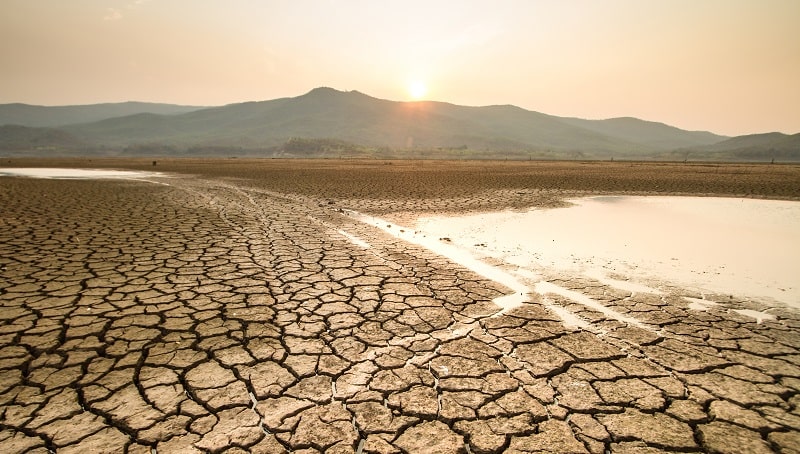The pika may be the next victim of climate change. Like animals across the globe, these tiny creatures are suffering because of climate change and may face extinction if we don’t take steps to save their little lives. Studies have revealed a sharp decline in pika populations. Although you might not even know what a pika is, their disappearance should worry you. Here’s why.
What is a Pika?
Pikas are small herbivores that live on the rocky slopes of mountains in America’s West. These tiny creatures are related to mice and rabbits. They have short legs and small, rounded ears. Most often a grayish-brown color, some pikas have more of a reddish-colored fur. They are usually about 6 inches in length and weigh between 4.5 and 7.1 ounces.
Although there are 29 different species of pikas, only two of these species live in North America. The majority of these furry little animals live in Central Asia. In fact, 23 of the 29 species of pikas can be found in China. Pikas can be divided into two broad categories: those that live in piles of broken rock (talus) and those that live in meadow or steppe environments, where they build burrows.
Rock-dwelling pikas.
The species of pikas that live in North America make their homes on rocky slopes high up in the mountains rather than digging burrows. Approximately half of the other species of pikas also live in these rocky habitats. On average, these rock-dwelling pikas live for about seven years. These species tend to live in small communities and have a fairly stable population. Usually, rock-dwelling pikas only manage to raise one litter per year. If this first litter doesn’t make it until weaning, they will have a second litter. Usually, the size of their litter is small. Rock-dwelling pikas are not very sociable and tend to lead rather solitary lives.
Burrow-building pikas.
In contrast to rock-dwelling pikas, burrow-building pikas have short lifespans and rarely live longer than one year. They live in large groups that can be as much as 30 times denser than their rock-dwelling counterparts and can produce multiple litters in a given year. Burrow-building pikas can breed up to five times in a year and can have as many as 13 pups in one litter. While rock-dwelling pikas are asocial, pikas that live in burrows usually live in large family groups.
The American Pika is Disappearing
A study conducted by the U.S. Geological Survey and a few of its partners found a startling decline of American Pika populations in recent years. This is particularly alarming because pikas are considered to be an “indicator” species. This means that their disappearance means that other animal species are also suffering due to changes in the ecosystem. Pikas are an easy animal to study because they are active during the day, and their sheer numbers make them easily detectable.
In 2014 and 2015, researchers surveyed pika populations in 910 locations across four states including the Great Basin. Comparing their findings with historical records, they discovered that pika populations had declined by more than 44 percent.
“Combined with our previous work across the western U.S., the results illustrate that pika losses are not confined solely to the Great Basin, but that the rate of decline is quite variable across the western landscape,” said Erik Beever, USGS research ecologist, and lead author of the study.
Climate Change and the Pika Mouse
So, why are pikas disappearing? According to Beever and his team of researchers, the answer is simple: climate change.
“It is certainly clear that changes we have observed in pika distribution are primarily governed by climate, given that nearly all of our climate-related predictions have been borne out,” Beever explained. “However, we are still refining our understanding of the exact combination of direct and indirect pathways by which climate is bringing about change.”
Among the environmental factors negatively impacting pika populations are temperature, precipitation, and inhabitable talus. However, of these factors, temperature appears to be the most crucial variable.
Instead of hibernating during the winter, the pika has a high internal temperature to stay warm in winter. Unfortunately, it can also die if its body temperature rises as little as 5.4 degrees Fahrenheit in the hot summers.
In the winter, however, the pika relies on heavy layers of snow to insulate its home in the mountains. If climate change decreases snowfall, the pika could freeze to death in the winter.
Can We Save Pikas from Extinction?
To have any chance at saving the pika animal, along with every other living thing on the planet, humans have got to change their habits to curb climate change. Despite knowing this, we have been frustratingly slow to take meaningful action to protect the environment.
“The climate crisis is worsening by the day, and the future will only become grimmer for temperature-sensitive animals like the pika,” said Shaye Wolf, the climate science director for the Center for Biological Diversity.
Activists continue their fight to get the American Pika placed on the endangered species list. But so far, they have been unsuccessful. Part of the reason officials continually refuses to give endangered status to the pika is the scope of the threat. These laws protect endangered animals from local threats rather than global threats, such as climate change.
“Listing the pika would have forced the Obama administration to take a hard look at climate change, and a very important part of that is bringing the Endangered Species Act toolkit to the fight against global warming,” Wolf said. “That was a fight in the Bush administration, and the Obama administration isn’t doing much better.”
And as the current presidential administration seems to have zero interest in the subject, it appears to have stalled there.
Pikas are Just One of Many
The pika is not alone. No matter where you look on the planet, animals are suffering from the devastating effects of climate change. As the temperature of the Earth increases, disappearing habitats and changing weather patterns pose a frightening threat. Unfortunately, it seems that humans will refuse to take this threat seriously until it is too late.
For more information on the disappearance of the American pika, please watch the following video from the Forest Service, featuring Pacific Southwest Station research ecologist Connie Millar.
-
Although disproved, the notion of a “climate change hiatus” is one that perpetuates in the…
-
The Arctic Shelf. Areas on our planet are defined by extremes. They represent the harsh…
-
Fossil fuels produce electricity, run car engines, make plastics, and power mills, factories, and industries.…
-
Oxygen is one of the most precious elements on Earth. Humans, plants, animals, and just…
-
If you pay any attention to the impact climate change is having on our planet,…
-
Methane gas is found in landfills, manure, and wetlands. Both natural and man-made activities produce…
-
The Colorado River winds its way through the Southwestern United States, ending in northern Mexico.…
-
Some people have proposed carbon sequestration as a solution to global climate change. But what…





